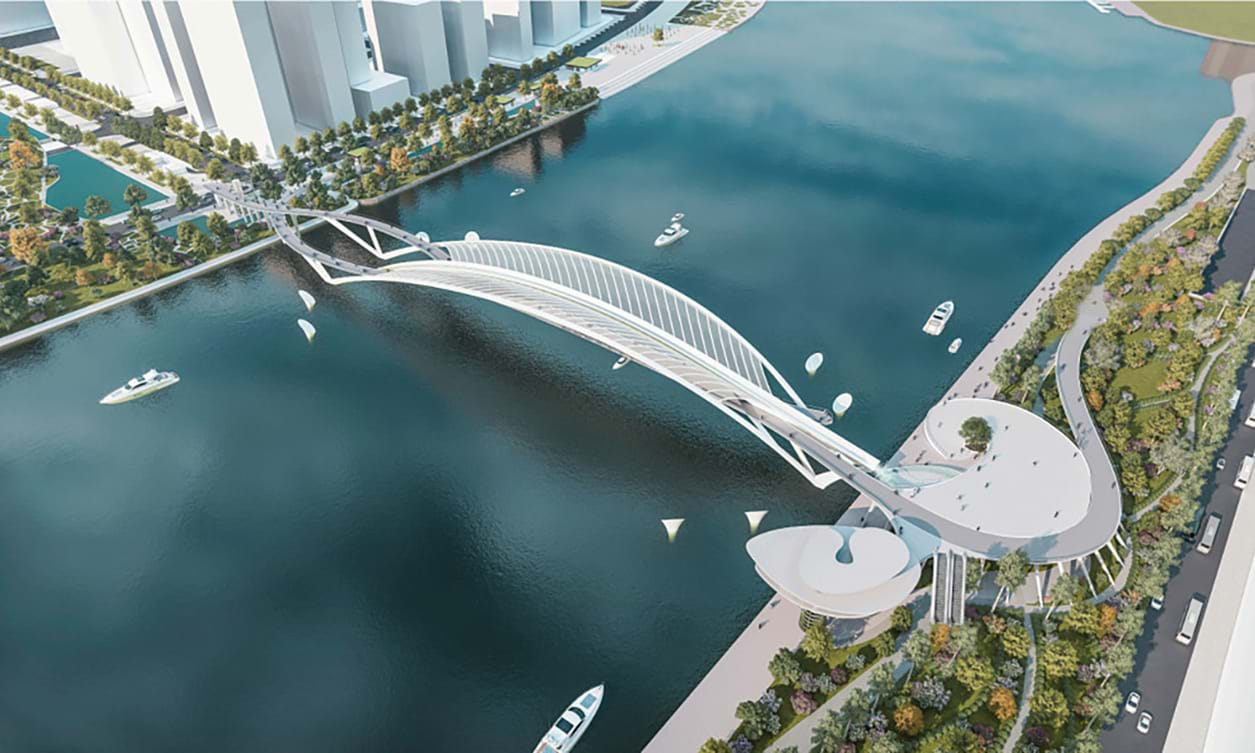The approved architectural design plan for the pedestrian bridge across the Saigon River has the image of nipa palm leaves, connecting the central area of District 1 with the new Thu Thiem urban area at Bach Dang wharf.
Ho Chi Minh City People's Committee has just decided on October 9 to approve the selection results of "Architectural design plan for pedestrian bridge across the Saigon River" as plan CDN01 of the joint venture Chodai-Takashi Niwa Architects and Chodai Kisojiban Vietnam.
Ho Chi Minh City People's Committee directed the Department of Planning and Architecture to announce the selection results according to regulations. At the same time, some points should be noted in the next steps:
The design plan needs to gather information, closely follow the content of the design task, and show appropriate connections with surrounding areas.
The detailed design stage needs to comply with the design idea and clarify the idea of the chosen option; It is necessary to ensure technical requirements, construction safety, architectural landscape, and legal compliance with approved planning.

The approved architectural design plan for the pedestrian bridge across the Saigon River has the image of nipa palm leaves. Photo: Consulting consortium
According to the report of the Department of Planning and Architecture requesting the People's Committee of Ho Chi Minh City to approve the selection results of "Architectural design plan for pedestrian bridge across the Saigon River", the CDN01 plan has the optimal image of nipa palm leaves. The column system is located on the river bed and brought close to the shore to create a large amount of underwater static and avoid collisions.
At the same time, the column system on the bridge surface is resolved due to the large crossing distance, so the visibility of pedestrians on the bridge is very clear. The circulating waterfall in plan CDN01 is very suitable for the design of Thu Thiem central square.
The architectural form is a unique, impressive, simple, yet attractive plan for residents and tourists coming to Ho Chi Minh City. In particular, the investment rate is feasible and has an accurate basis.
With the form of selecting 12 architectural design options, choosing the most optimal option as the basis for approving the project proposal, the Selection Council reviewed and evaluated 4 design options of 4 units. consultants participated in the selection, unanimously ranked the results of round 2: The CDN01 plan of the joint venture Chodai-Takashi Niwa Architects and Chodai Kisojiban Vietnam achieved the highest score (87.92 points), being the most optimal plan in the competition. Selected "Architectural design plan for pedestrian bridge across Saigon River".
The winning unit commits that the design plan participating in the selection does not violate copyright, creative ideas or plans in other projects.
The specific technical parameters of the design plan for the pedestrian bridge across the Saigon River will continue to be researched, supplemented and improved in the next design steps, ensuring compliance with regulations.

Consulting units presented their plans to participate in the evaluation session on January 14, 2020. Photo: CTV
According to the decision approving the design task to organize the selection of "Architectural design plan for pedestrian bridge across the Saigon River" in September 2019, the pedestrian bridge across the Saigon River (pedestrian bridge No. 1 - southern bridge) connects Central area of District 1 with Thu Thiem new urban area, District 2 (currently in Thu Duc City). The bridge location is between Thu Thiem 2 bridge (currently Ba Son bridge) and the Saigon River crossing tunnel.
On the District 1 side, the foot of the bridge is located in the Bach Dang wharf park area and closest to Nguyen Hue walking street. On the District 2 side, the foot of the bridge is located at the riverbank park and outside the boundary of zone A, south of the central square in Thu Thiem new urban area (Ho Chi Minh park).
The bridge is mainly used for walking, and also has lanes for cyclists. Pedestrians, cyclists, people with disabilities, children, the elderly... can access and move easily. Can be used in combination with conveyor belts, ramps, elevators...; Prohibit all forms of trading and business...
Ho Chi Minh City People's Committee also noted researching parking areas and supporting service facilities (toilets, water stands...) for tourists at the two ends of the bridge. The bridge design needs to ensure it can accommodate rescue vehicles traveling on the bridge...












